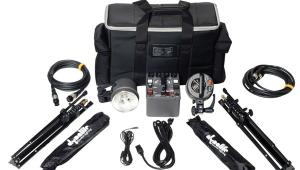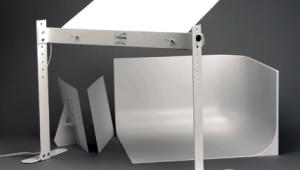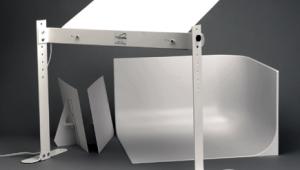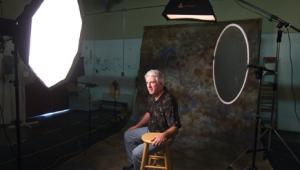Close-Up Lighting, Soft And Easy; Adapting Light To Macro Photography
Taking good close-up pictures of most any small subject a foot or less away from the lens is relatively easy these days, what with the macro-focusing capability found on some zoom lenses. That's no problem when you use available light. But what happens when you want or need to add auxiliary light to the scene? The tiny flash built into many current SLR cameras is designed to cover subjects from about 5-15 ft away. And the majority of auxiliary shoe-mount flash units are similarly designed, albeit with more capability for bounce and even for some downward tilt. But let's face it, light emitted from a single flash is often harsh, and its unidirectional quality usually casts a strong, objectionable shadow.
 |
|
|
That's when a class of flash units, known as ringlights, comes into
play. They can provide soft, even lighting suitable for nearly all types of
small subjects. A number of ringlight models have two or four small flash tubes
around the lens itself to direct nearly shadowless, wraparound, light onto the
scene. Since these lights are very close to the lens, they properly illuminate
really close subjects by spreading the light toward the subject from all sides.
When there are two or four flash tubes, the lighting is more diffuse and even,
so shadows are less pronounced and bothersome. (Keep in mind that ringlights
are made specifically for close-up work and have very limited light output,
thus are not appropriate for subjects even 5 or 10 ft away. However, there are
a few models that produce more powerful output, often used by fashion photographers.)
These days you can mount the ringlight on your lens, set your camera on Program
and be assured of rather good exposures, thanks to dedicated flashes and TTL
exposure automation. However, this course typically results in a relatively
large lens opening, which yields a very shallow depth of field. For more control
over depth of field switch the camera's command dial over to "A"
(Aperture Priority) and select an opening of f/16 or f/22 to obtain more depth
of field. Check the results by using your depth of field preview function on
your camera before exposure. For flat subjects, be sure to keep the camera positioned
parallel to the subject for good focus across the field.
Despite the seeming ease of work, ringlights are certainly not perfect. Although
the light produced by ringlights is nearly shadowless, they still can produce
glare on reflective subjects. That's when tent lighting comes into play
(a diffuse cloth over the subject, through which you aim illumination). But
some ringlights allow you to turn off the flash tube on one of the two lights
(or two of the tubes if the unit has four lights), so you can obtain more light
control.
Two New Ringlights
For examples to illustrate this article I worked with two relatively new close-up
ringlights--the Phoenix DRLLD Digital LED Ring Light and the PROMASTER
MacroLume TTL Macro Flash.
 |
|
|
The new Phoenix DRLLD Digital LED Ring Light (www.omegasatter.com) is unique as it has a ring of 12 daylight-balanced LED lights that circle the lens (instead of the typical two or four flash tubes) that emit constant illumination for shadow-free close-up lighting. The light output is considerably less than flash ringlights so it's only suitable for small subjects about 1-10" away. The exposure is based on the camera's internal metering and usually relies upon slower shutter speeds so the camera must be held very steady, or better yet, a tripod should be used. It's intended for use with digital cameras since they can be adjusted to conform to the 3000ÞK light, but it can be used with film, too, though some filtration will undoubtedly be needed to correct the color balance. When I tested a sample unit on film, the lab balanced the color negative prints very nicely, even though I shot without any filtration with Kodak's High Definition 400 color negative film.
The Phoenix DRLLD Digital LED Ring Light is very simple and easy to operate.
There is just one master on/off switch and you can use it with either battery
or AC power. The light produced is soft and evenly distributed over the subject
and since the light stays on while in use, you can easily focus and compose
the subject. The MSRP is $150.
The MacroLume TTL Macro Flash from PROMASTER (www.promaster.com)
is a new "digital" version of their ringlight that's now fully
compatible with digital and film SLR system cameras. To achieve fully dedicated
compatibility with different cameras it must be connected to one of the PROMASTER
5000 series of connecting flash shoe modules. One major difference from other
brands of ringlights is the entire ring flash head can be removed from the camera
lens (where it works with Cokin "P" series of adapter rings ranging
from 48-82mm or a 49 or 52mm adapter ring that comes with the unit) and connected
to the power supply unit on the camera's hot shoe. Attached in this manner,
it can be used as a normal diffused output flash. When the ringlight is attached
to the power supply the head can be tilted slightly upward and downward to direct
the light exactly where needed. A nice touch is that the two flash tubes on
each side also have a pulsed lamp, which can be useful for determining if there
are any bothersome reflections and to check the lighting ratio between the two
tubes. The MSRP is $300.
 |
|
|
A Ringlight Sampler
Nikon offers two versions of their new Wireless Close-Up Speedlight System,
the R1C1 and the R1, both of which operate with Nikon's i-TTL wireless
creative lighting system found on many of their film and digital SLR cameras.
This system consists of two independent SB-R200 Wireless Speedlights that can
be positioned either on the attachment ring mounted on the camera lens (where
they can be independently angled to direct the light exactly where needed) or
supported and positioned independently about the subject on provided stands.
You can use the two lights in tandem or just one light for more creative close-up
light control.
 |
|
|















































